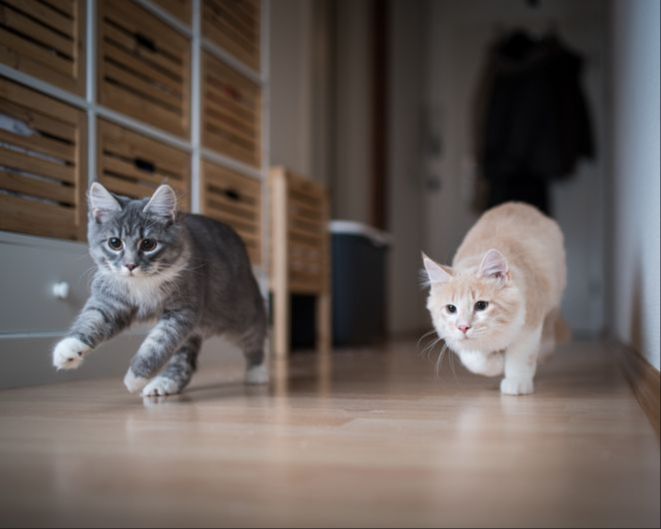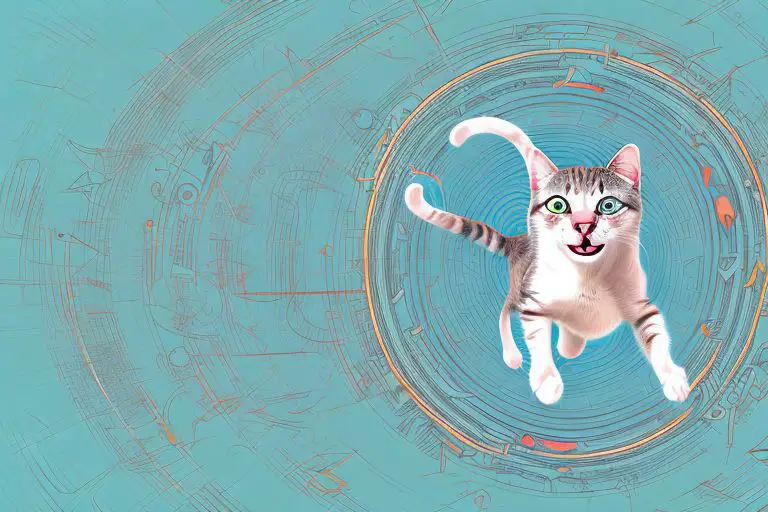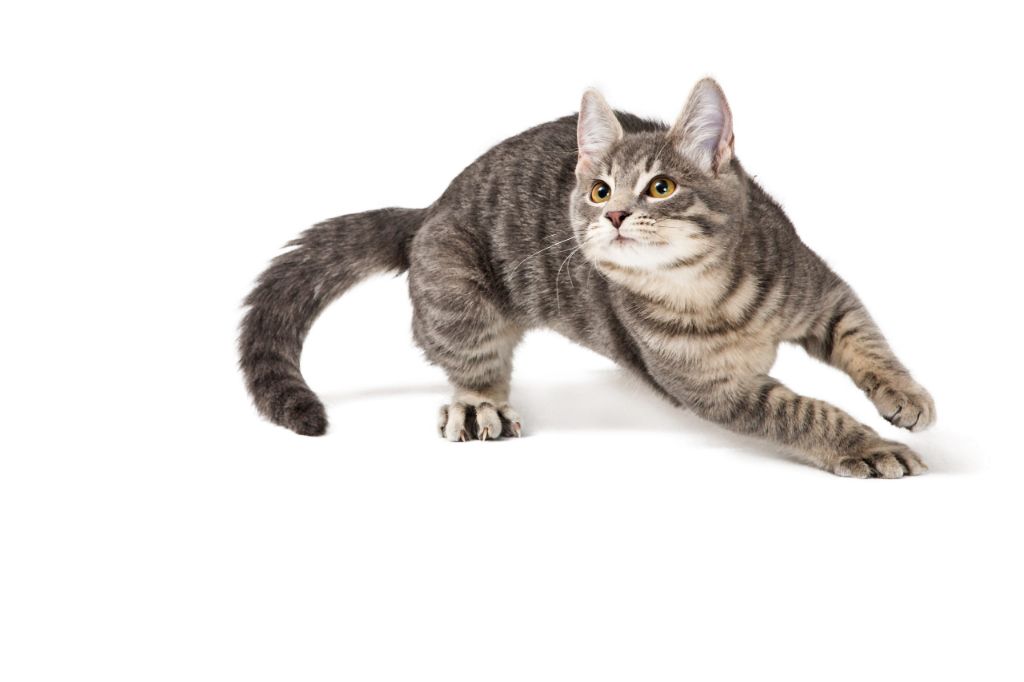What Are Cat Zoomies?

Cat zoomies, also sometimes known as cat crazies, are sudden and seemingly unprovoked bursts of energetic and playful behavior in cats (American Society for the Prevention of Cruelty to Animals). During a zoomie episode, a cat will frantically run around, jump on and off furniture, rapidly change directions, and act in a frenzied manner (Vet Voice). This hyperactive behavior typically lasts around 10 minutes, after which the cat will abruptly stop and return to normal (Daily Paws).
Some characteristic behaviors of cat zoomies include rapid sprinting, jumping up walls or furniture, playing intensely with toys, darting back and forth through the house, rolling on the floor, and making energetic vocalizations (Four Paws). It’s as if the cat is possessed by a sudden boost of energy and excitement (Daily Paws). While zoomies may seem random to owners, they are perfectly normal and are considered play behavior for cats.
Zoomies can occur at any age, but are most common in younger cats and kittens. They often happen in the evenings when cats are most active (Four Paws). While the exact cause is unknown, zoomies are believed to be an expression of a cat’s natural prey drive and instinct to hunt, chase, and play (Vet Voice). For indoor cats especially, zoomies provide an outlet for this energy and mimics physical activities their ancestors would perform in the wild.
Why Do Cats Get the Zoomies?
Cats experience bursts of frantic activity known as the zoomies for several possible reasons. The most common cause of zoomies is pent up energy. Cats are natural predators that have evolved to conserve energy with long napping periods, then expend it quickly in intense bursts of activity when hunting. With domestic cats, the zoomies serve as an outlet for releasing that built up energy since they aren’t able to hunt.
Another driver of zoomies is playfulness. Zooming around helps satisfy a cat’s prey drive and desire for play when they can’t hunt real prey. It allows them to practice important predator skills like running, pouncing, leaping, and twisting. So zoomies are often a sign that a cat is in an energetic, playful mood.
Safe environments also encourage zoomies. Cats zoom when they feel comfortable and free from stress. A content cat that feels secure in their home and bonded with their owner is more likely to have zoomie bursts. Zooming is typically reserved for familiar environments, so it shows a cat is at ease.
In summary, pent up energy, playfulness, and comfort are main reasons for the zoomies in cats. This behavior allows them to satisfy their instincts in a domestic setting. https://www.dailypaws.com/cats-kittens/behavior/common-cat-behaviors/cat-zoomies
Zoomies Are a Sign of a Happy, Healthy Cat

Experts agree that cat zoomies usually indicate a happy, comfortable, and energetic feline. According to Fetch Pet, most zoomies are a “healthy expression of excitement.” Reddit users confirm this perspective, stating that “Zoomies means they are expending energy and are happy and lively and feel good.” When cats experience bursts of energy and joy, they express it through playful zooming. The vet site Vet Voice explains that this hyperactive behavior reflects good health and vitality. Essentially, zoomies are your cat’s way of saying they feel content, active, and enthusiastic.
So if you notice your furry friend suddenly sprinting, spinning, leaping, and rolling around the room, see it as a positive sign. The zoomies mean your cat is thrilled about life in that moment. Their wild play shows they have a natural outlet for their energy and emotions. An active cat is generally a healthy and happy cat. By embracing and even encouraging your cat’s zoomie behavior, you can help support their mental and physical wellbeing. The next time your cat gets the zoomies, enjoy the entertaining display – and remember it likely means they feel wonderful!
The Science Behind the Zoomies
The science behind cat zoomies explains how they are connected to surges in neurotransmitters – signaling molecules in the brain. When cats have zoomies, they experience a rush of dopamine, serotonin, and other chemicals that provide a mood boost.
Dopamine, often called the “feel good” neurotransmitter, is especially involved in zoomies. This chemical is associated with reward and pleasure. As cats play during zoomies, dopamine is released, creating a natural high.
In addition to dopamine, the neurotransmitter serotonin rises during zoomies. Serotonin regulates mood, and elevated levels lead to increased feelings of energy and delight. The boost in serotonin contributes to the frenetic energy and jubilant behavior seen during zoomies.
Endorphins, the body’s natural pain relievers, may also rise during bouts of intense physical zoomie activity. These chemicals generate euphoric feelings and additional energy. The endorphin rush makes zoomies even more enjoyable for cats.
So in summary, zoomies occur due to surges in neurotransmitters like dopamine, serotonin, and endorphins. This creates a positive feedback loop, where cats become more energetic and playful, leading to the release of more mood-boosting chemicals.
Zoomies as Play Behavior

Zoomies are often interpreted as a form of play for cats. Cats naturally have quick bursts of energy and enjoy chasing prey. Zoomies allow them to emulate hunting behaviors in a playful way. According to Four Paws, zoomies satisfy a cat’s instinct to hunt, run, and play. The random energy bursts let them behaviorally mimic the act of chasing prey.
Play is very beneficial for cats. It helps them burn off excess energy, keeps their bodies and minds active, relieves boredom, and strengthens the human-feline bond. Zoomies are an opportunity for aerobic exercise and mental stimulation. The Mayo Clinic states that play sessions can providecats with needed activity to stay at a healthy weight and avoid obesity-related illnesses.
Since zoomies emerge spontaneously, they encourage cats to be more active. Zooming around the house or wrestling with toys are great ways for cats to incorporate physical activity into their daily routine. Overall, embracing your cat’s zoomies will keep them happily entertained. It satisfies their natural instincts in a safe, playful way.
Encouraging Healthy Zoomies
Although zoomies may seem random, there are some things cat owners can do to promote natural zoomie behavior. Getting plenty of playtime is an important way to keep your cat active and give them an outlet for their energy. Try to have regular play sessions throughout the day using toys that allow cats to run and chase like feather wands or laser pointers. Just be sure to let your cat actually catch the toy and “kill” it at the end to satisfy their predatory instincts[1].
Providing cat trees, scratching posts, and high perches around your home is another good way to encourage zoomies. Cats love to climb, perch, and leap during zoomies, so having vertical space and different levels allows them to get the full zoomie experience. Place perches and cat trees near windows so your cat can survey the outdoors. The Cat Exercise Wheel is also a great option for an indoor zoomie workout.
Lastly, make sure your cat’s basic needs are being met with a proper diet, clean litter boxes, and a consistent daily routine. Cats that become bored, stressed, or restless may resort to nuisance zoomies, so meeting their needs is key for healthy zoomie habits[2].
[1] https://www.cats.org.uk/cats-blog/6-tips-for-preventing-cat-zoomies
[2] https://flappy.fish/how-to-prevent-4am-zoomies-calm-your-cat-down
Zoomie Triggers to Avoid
While zoomies are often a healthy expression of energy in cats, they can sometimes be triggered by negative factors. It’s important to be aware of situations that may lead to unhealthy zoomies.
Stress is one potential zoomie trigger to watch out for. Major changes in a cat’s environment, disruptions to their routine, or introductions to new people or animals can cause stress. A stressed cat may react by suddenly sprinting around the house. Try to minimize stressful events and provide calming stimuli like pheromone diffusers when changes occur.
Lack of physical and mental stimulation can also lead to zoomies. Cats need interactive playtime, opportunities to climb and scratch, and toys that challenge their natural hunting instincts. Without adequate stimulation, your cat may zoom around seeking an activity outlet. Make sure to schedule regular play sessions throughout the day.
Sudden bursts of zoomies late at night or as a reaction to scolding are other signs your cat may need more appropriate outlets for their energy. If zoomies happen frequently at inconvenient times, examine their daily routine and enrichment.
While healthy zoomies are normal, uncontrolled running triggered by stress or boredom can be disruptive. Pay attention to any behavioral or environmental factors that precede zoomie episodes to discern the cause.
Zoomie Precautions

While zoomies are generally harmless, owners should take some basic precautions to keep their cats safe during bouts of frantic sprinting and jumping:
Remove breakable objects and other potential hazards from the zoom zone. Things like vases, electronics, and decor items could get knocked over or damaged during energetic zooming. Clear walkways and restrict access to balconies, fireplaces, and staircases if possible.
Provide supervision during zoomies to redirect any destructive behavior. Cats may accidentally tear into furniture, curtains, or houseplants in their hyperactive state if left unmonitored.
Keep other pets separated if needed. Some cats zoom and pounce aggressively, which could unintentionally harm smaller animals. Separate anxious pets who get stressed by zooming cats.
Invest in scratching posts and vertical scratchers to protect furniture and carpets. Offer appropriate and attractive scratching surfaces around zoom zones.
Consider temporary confinement in a cat-proofed room or pen to limit access and damage if zoomies become excessive. This also allows the cat to zoom safely without the risk of bolting out doors or windows accidentally left open.
Check for injuries after prolonged or intense zooming episodes. Overzealous playing or pouncing during the zoomies could result in minor cuts, scratches, or strained muscles that require first aid.
Never punish or scold a cat for zooming behavior. Zoomies are a natural feline behavior. Punishment will not change the behavior.
Cats should be closely monitored during zoomies until they settle down. Taking basic safety precautions allows cats to enjoy healthy zooming while preventing any potential destruction or injuries.
Sources:
https://www.insider.com/guides/pets/cat-zoomies
https://www.hillspet.com/cat-care/behavior-appearance/what-are-cat-zoomies
When to See the Vet
While zoomies are typically a normal behavior for cats, there are some instances where frequent or intense zooming may indicate an underlying medical issue that requires veterinary examination:
If your cat has sudden onset of frequent zoomies, especially outside of their normal active times, it could signify pain, stress, or anxiety. Sudden behavior changes warrant a vet visit to identify the cause.
Cats with hyperthyroidism or diabetes may experience more frequent or longer zoomie episodes. These conditions can cause restlessness and agitation. Your vet can test for hyperthyroidism and diabetes.
Elderly cats experiencing disorientation or cognitive decline may zoom aimlessly or seem confused during zoomies. It’s important to rule out medical conditions that can cause this behavior.
If zoomies are accompanied by aggressive behavior like biting or scratching, vet examination can determine if there’s an underlying cause like stress, fear, or sickness provoking this.
Frequent zoomies late at night could indicate a disrupted sleep cycle or insomnia, which could stem from anxiety, pain, or disease. Talk to your vet to identify factors affecting your cat’s sleep.
While occasional zoomies are normal, speak to your vet if they become very frequent, intense, or are accompanied by other behavioral or physical changes in your cat. Proper diagnosis will allow treatment of any condition causing excessive zooming.
Zoom On! Embrace Your Cat’s Zoomies
In summary, cat zoomies are a completely natural behavior that signify a happy, healthy cat. While zoomies may seem silly or disruptive at times, they are your cat’s way of expressing their wild nature through play. The best way to respond when your cat gets the zoomies is to provide them safe spaces to zoom and plenty of playtime and enriching activities. Avoid triggers like overstimulation that can lead to problem behaviors. As long as your cat is zooming in a healthy way, sit back and enjoy the show! Cherish these moments that allow you to see your cat’s energetic, playful spirit emerge.
Embracing your cat’s zoomies allows them to engage in natural behaviors that provide both mental and physical enrichment. Next time your cat starts sprinting, hopping, or darting around, see it as a chance to bond and play. Cats thrive when their environment and care meet their needs, so take your cat’s zoomies as a sign you’re doing things right! If you ensure your cat’s overall health and happiness, the zoomies will be a delightful display of your furry friend feeling content at home.
